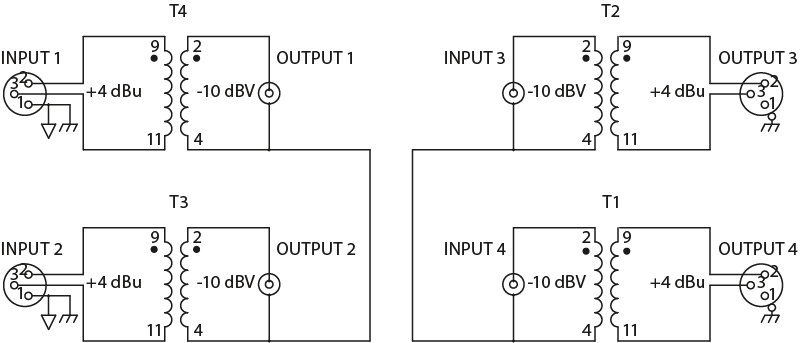
The Rane BB 44X Balance Buddy is a handy professional-grade tool used to convert and provide isolation for unbalanced -10 dBV consumer level RCA outputs up to balanced +4 dBu professional XLR inputs—and vice-versa. Two channels each way, or a stereo pair each way (however you prefer to think about it). The BB 44X converts one pair from -10 dBV to +4 dBu and another pair from +4 dBu to -10 dBV simultaneously. There are two female and two male XLR connectors, and four RCA jacks.
Unbalanced lines should always be kept to 10 feet (3 meters) or less to prevent undesireable effects such as hum and noise. The BB 44X allows conversion to balanced lines that can be run across a studio or a house without loss of signal quality. For instance, a stereo tape recorder with RCA connectors attaches easily—inputs and outputs—to one BB 44X, allowing record source and playback amplifiers to be in another room.
Signal-to-noise performance is perfectly preserved using the BB 44X, since it uses only passive transformers to convert signal levels. It adds no additional noise whatsoever. Use of professional quality nickel core (“80” Ni) transformers guarantee low distortion, wide bandwidth and high signal level handling capability.
The BB 44X’s isolation transformers provide a quick and affordable answer to most jobs requiring signal level conversion and output balancing.
Conversion Ratio
The casual observer would think to convert -10 dBV to +4 dBu, you would need 14 dB of gain. The casual observer would be wrong. You only need 12 dB of gain. The reason is not only do you change levels, you also change reference levels—from dBV to dBu. The first (dBV) references everything to 1.0 volt, while the second (dBu) references everything to 0.775 volts (this comes from the old power reference of 0 dBm, which equaled 1mW into 600 Ω, which equaled .775 volts).
Driving Impedances
Some people wrongly feel you cannot use a transformer to convert between -10 dBV and +4 dBu because of low impedances. This is not a problem as long as you use them to interconnect equipment with at least 15 kΩ input impedance. Since most professional products have input impedances of 20 kΩ or greater (50k and 100 kΩ are not uncommon), this should never be difficult. A 15 kΩ load winds up looking like 1 kΩ to the equipment with the -10 dBV output (due to transformer action). This may seem excessively low, but is not in practice. The maximum transformer output level of +24 dBu occurs with an input level of +10 dBV, which equals 3.16 volts. And 3.16 volts driving 1 kΩ only requires 3.16 milliamps, which is a very modest requirement for any -10 dBV equipment to deliver.
Wiring
The BB 44X follows AES/ANSI/IEC standards of pin 2 positive and pin 3 negative. Note the shields (commons) of the RCA jacks are tied for the Inputs and the Outputs but not to each other. This allows ground isolation of stereo Input and Output pairs. A positive signal applied to pin 2 of the XLR connectors causes a positive signal to appear on the tip of the associated RCA jacks, and vice-versa.
Signal Direction
Signal can be converted through the channels either direction. That means there is the possibility of having four channels -10 dBV unbalanced to +4 dBu balanced, or vice versa (in the standard unit). The only problem arises in the gender of the XLR connector. The solution requires same-sex XLR adaptors or special cables.
Chassis Grounding
A tapped hole and a #6-32 screw is provided for chassis grounding purposes. Good practice dictates earth-grounding the BB 44X. If the grounding integrity of the rack screws is in doubt, run a wire from this screw to a known earth ground.
BLOCK DIAGRAM


The OPT 88 (Option 88) expands the BB 44X into an eight channel model. The OPT 88 consists of a printed circuit board with four additional transformers and jacks soldered in place. The OPT 88 installs easily in the blank side of the BB 44X. Assembly is simple: remove the cover, install the board in place, and secure with the supplied mounting screws. No soldering required; all you need are #1 and #2 Phillips screwdrivers. The OPT 88 can be used independently as a circuit board without a chassis.

Each unit is shipped with the Manual containing the schematic, the RaneNote "Sound System Interconnection," Declaration of Conformity, and Rane's 2+ Year Warranty information.
Will the unit work in reverse (i.e. is it bi-directional)?
Yes. The products do not have a required signal flow. Simply use the inputs as outputs and vice versa. Note: The OPTION 88 works exactly the same as the BB 44x, since the same circuit board is used.
If the above doesn't answer your question, or it's urgent...
Phone 425-355-6000, 8:30 AM to 5 PM PST, Monday through Friday.
If it's less urgent, you can email the factory.
